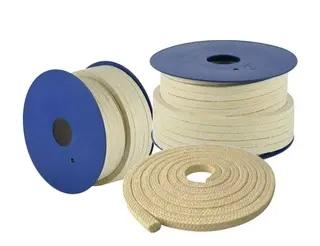Aramid Fiber Packing: Characteristics, Applications, and Best Practices
In industrial operations, sealing materials play a decisive role in maintaining equipment stability and safety. Among them, aramid fiber packing has emerged as a high-performance solution favored by engineers worldwide. With outstanding strength, chemical resistance, and durability, it is widely applied in pumps, valves, compressors, and other critical machinery. This article provides a comprehensive overview of aramid fiber packing, including its characteristics, advantages, application areas, and key points for use and maintenance.
Characteristics of Aramid Fiber
Aramid fiber (aromatic polyamide fiber) is a special polymer material in which over 85% of the amide bonds are directly linked to benzene rings. This unique molecular structure endows aramid with flame resistance, high strength, high modulus, thermal stability, and excellent insulation properties.
Commercially, aramid fibers are mainly classified into two categories:
1. Meta-Aramid (MPIA, Aramid 1313)
-
Thermal stability: Long-term use at 200 °C with minimal aging.
-
Flame resistance: LOI > 28%, does not melt or drip, self-extinguishes when removed from flame.
-
Electrical insulation: Breakdown voltage up to 20 kV/mm.
-
Corrosion & radiation resistance: Resistant to acids, bases, and radiation damage.
-
Processability: Flexible, with good elongation, suitable for standard textile equipment.
2. Para-Aramid (PPTA, Aramid 1414)
-
High strength & modulus: Six times the tensile strength of steel wire with only one-fifth the density.
-
Thermal resistance: Maintains strength at 200 °C; stable up to 560 °C without decomposition.
-
Impact resistance: Excellent fatigue resistance, widely known as "bulletproof fiber."
-
Limitation: Difficult to degrade, presenting recycling and disposal challenges.
Characteristics of Aramid Fiber Packing
Aramid fiber packing is produced by braiding aramid yarns impregnated with PTFE dispersion and lubricant. This treatment significantly enhances sealing performance and durability.
Key features include:
-
Excellent chemical resistance – Withstands strong acids, alkalis, and solvents, ideal for chemical and pharmaceutical applications.
-
High resilience & low cold flow – Maintains structure under high temperature and pressure, resisting deformation and extrusion.
-
Exceptional strength & modulus – Performs reliably in high-speed, high-pressure equipment, often referred to as "artificial metallic wire."
-
Ease of disassembly – Simple removal and installation reduce maintenance downtime and costs.
Applications of Aramid Fiber Packing
Thanks to its performance advantages, aramid fiber packing is widely used across multiple industries, particularly in harsh operating conditions:
-
Pumps – Reliable alternative to asbestos packing, suitable for high-temperature, corrosive environments.
-
Valves – Prevents leakage under extreme conditions, ensuring reliable flow control.
-
Mixers – Resists wear during high-pressure mixing processes in chemical and pharmaceutical industries.
-
Compressors – Provides durable sealing in high-temperature, high-pressure systems.
-
Other equipment – Applied in reactors, pipeline joints, and other systems requiring robust sealing solutions.
Best Practices for Use and Maintenance
The performance of aramid fiber packing is highly dependent on correct installation and upkeep.
Installation Steps
-
Loosen gland bolts to release pressure.
-
Remove old packing and thoroughly clean the stuffing box.
-
Inspect shaft/rod for corrosion, wear, or scratches, replacing defective components.
-
Install new rings carefully, tightening bolts evenly. Avoid overtightening to prevent burnout.
-
Monitor leakage – A small, controlled amount is normal; excessive tightening can shorten packing life.
Maintenance Guidelines
-
Avoid additional lubricants – They may impair sealing performance and increase wear.
-
Regular inspection – Replace aged or worn packing promptly.
-
Select pure aramid packing – Avoid low-quality blends with inferior fibers that compromise performance.
Factors Affecting Performance
Several variables influence the sealing efficiency and durability of aramid packing:
-
Braiding density – Higher density improves wear resistance and leakage control.
-
Braiding method – Interlock braiding offers uniform density, better lubrication retention, and longer service life.
-
Size accuracy – Correct dimensions ensure proper installation and minimize downtime.
-
Production quality – Multi-spindle braiding machines yield smoother, denser surfaces with superior sealing properties.
Conclusion
Aramid fiber packing is a high-performance sealing solution offering outstanding strength, chemical resistance, resilience, and durability. By selecting the right type of packing and following best practices in installation and maintenance, industries can achieve longer equipment life, reduced leakage, and improved operational efficiency.
As industrial demands grow more challenging, aramid fiber packing continues to prove itself as a reliable alternative to traditional materials, safeguarding the stability and safety of critical equipment across diverse applications.
It's important to know about Google SEO to help your website rank higher in search results.

